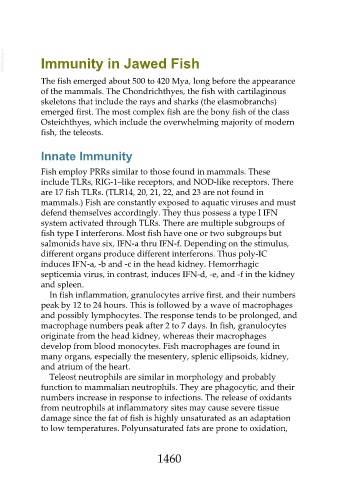Page 1460 - Veterinary Immunology, 10th Edition
P. 1460
VetBooks.ir Immunity in Jawed Fish
The fish emerged about 500 to 420 Mya, long before the appearance
of the mammals. The Chondrichthyes, the fish with cartilaginous
skeletons that include the rays and sharks (the elasmobranchs)
emerged first. The most complex fish are the bony fish of the class
Osteichthyes, which include the overwhelming majority of modern
fish, the teleosts.
Innate Immunity
Fish employ PRRs similar to those found in mammals. These
include TLRs, RIG-1–like receptors, and NOD-like receptors. There
are 17 fish TLRs. (TLR14, 20, 21, 22, and 23 are not found in
mammals.) Fish are constantly exposed to aquatic viruses and must
defend themselves accordingly. They thus possess a type I IFN
system activated through TLRs. There are multiple subgroups of
fish type I interferons. Most fish have one or two subgroups but
salmonids have six, IFN-a thru IFN-f. Depending on the stimulus,
different organs produce different interferons. Thus poly-IC
induces IFN-a, -b and -c in the head kidney. Hemorrhagic
septicemia virus, in contrast, induces IFN-d, -e, and -f in the kidney
and spleen.
In fish inflammation, granulocytes arrive first, and their numbers
peak by 12 to 24 hours. This is followed by a wave of macrophages
and possibly lymphocytes. The response tends to be prolonged, and
macrophage numbers peak after 2 to 7 days. In fish, granulocytes
originate from the head kidney, whereas their macrophages
develop from blood monocytes. Fish macrophages are found in
many organs, especially the mesentery, splenic ellipsoids, kidney,
and atrium of the heart.
Teleost neutrophils are similar in morphology and probably
function to mammalian neutrophils. They are phagocytic, and their
numbers increase in response to infections. The release of oxidants
from neutrophils at inflammatory sites may cause severe tissue
damage since the fat of fish is highly unsaturated as an adaptation
to low temperatures. Polyunsaturated fats are prone to oxidation,
1460

